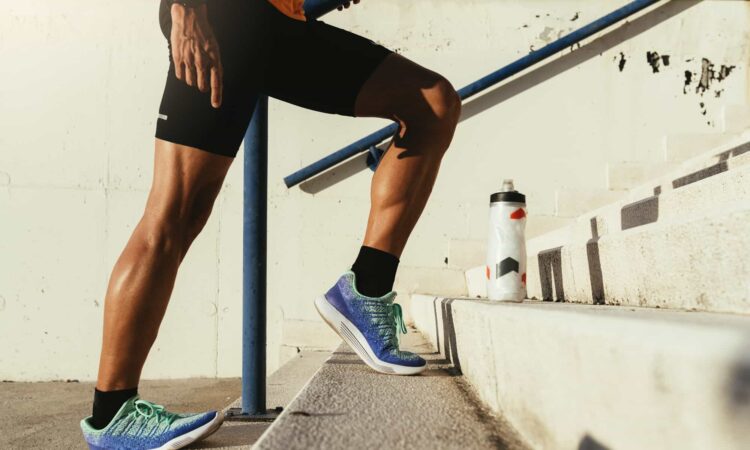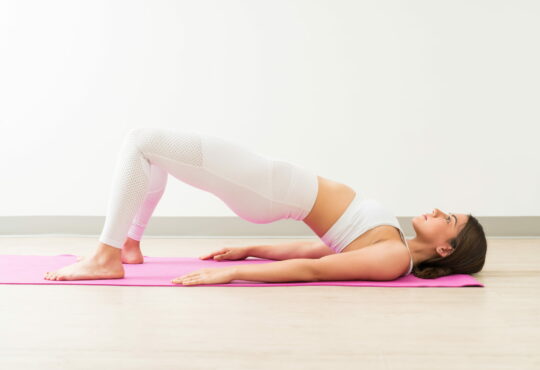
They’re simple and easy.
Even “girls” can complete the full exercise.
Anybody can, as long as you have at least one functional leg with your foot.
You can perform them at your desk at work or school while listening to a lecture. In meetings or while watching movies.
They’re a perfect way for injured athletes to avoid going too fat while they’re sidelined to heal, and for when you’re stuck on an airplane.
No equipment is needed.
No weights.
No gym.
No personal trainer.
Not even any floor space – beyond you seated in a chair.
You do them sitting down.
Nobody even has to know you’re “working out.”
They use only 1% of your body’s muscle mass, so you won’t need to take a shower.
It’s the soleus pushup.
What is a Soleus?
The soleus is the wide, flat muscle in the back of your calves. It’s the lower part of your calf muscle.
It’s not famous. Unless you’re a serious runner, you probably haven’t heard of it.
However, it’s unique because it consists only of slow-twitch fibers. That means it’s designed to be used continuously.
It stabilizes your body when you’re standing when you’re walking and when you’re running.
So, it’s pretty important for a little-known muscle. Our other muscles want to stop and rest after they’ve done some work. Just try lifting even a lightweight with your biceps hundreds or thousands of times without stopping – that won’t happen even if you’re a world-class weightlifter. But your soleus is intended to just keep on going and going.
What is a Soleus Pushup?
A soleus pushup is a slight movement needed to exercise your soleus muscle.
1. Have one foot flat on the floor. Your leg is bent at a 90-degree angle.
2. Keeping the ball of your foot in contact with the floor, raise your heel almost all the way up.
3. Return your heel back down to the floor.
4 Repeat.
That’s it.
You don’t even try to push down to create resistance. Just keep the ball of your foot flat on the floor, lift your heel up and down, over and over.
Where Did the Soleus Pushup Come From?
The University of Houston recently published the study in iScience.
Apparently, they had the idea to test this one micro-exercise or micro-movement because you can perform it over and over, for hours at a time.
We know exercise helps control the levels of sugar – glucose – and fat in our blood. But most of us live sedentary lives. We don’t normally move as much as we used to just to earn our paychecks. And most people don’t have the time or inclination to go to the gym.
The scientists wanted to see if exercising this one muscle could improve the health of otherwise sedentary people who are never going to run a marathon or lift weights.
They selected an equal number of male and female subjects, and they were a wide range of ages and body mass indices.
So they had the volunteers perform the soleus pushup up to 4 1/2 hours per day. That’s total, though – not all at once. They took breaks.
The researchers found this resulted in significant improvements in blood sugar utilization and metabolism in the subjects.
We Need Exercise to Manage Blood Sugar
Medical science knows that how our bodies regulate and control blood sugar and fats, and how efficiently our bodies burn glucose for energy – or store it as fat – has a huge impact on our health.
Sugar is quite similar to oxygen. We need both because we burn them for energy, but they’re both potentially dangerous.
At high levels, sugar damages your blood vessels and nerves. That’s why diabetics are at high risk of blindness and having their feet amputated. Both are caused by poor blood circulation because chronically high sugar damages veins and arteries.
It’s also why diabetics suffer from neuropathy – pain in their nerves that are damaged by sugar.
For optimal health, our bodies must carry out a difficult, “Goldilocks” balance. We need some glucose in our blood because our cells need to burn it for energy. But too many damages our blood vessel linings and nerves. Too little, though, and we feel faint and hungry.
We need just enough.
Exercise is critical for this, but few of us get enough.
As we age, it’s harder for our bodies to control blood sugar and how much gets burned for energy – especially also because most of us consume far too much food, especially processed sugar and grains.
Your blood sugar goes up every time you eat – which should be fine, it’s why we eat.
But when that sugar spike is not well controlled by the hormone insulin, it goes higher – and stays high – longer than is optimally healthy.
You develop insulin resistance, where your cells are refusing to take in the sugar, so it remains in your blood until it’s stored as fat.
Over time, this leads to weight gain and increased risk of Type 2 diabetes.
Health Benefits of Soleus Pushups for the Subjects
On average, their after-meal glucose spikes were 52% smaller. That’s incredibly beneficial.
Their insulin levels went down by 60%.
And these subjects had large improvements in their overall metabolisms.
They reduced the number of lipids in their blood, improving their ability to burn fat instead of store it.
The One Disadvantage
The results take time.
The most successful subjects did their soleus pushups for 4 1/2 hours every day.
Although it’s simple and easy, it takes a little conscious attention and mental energy to keep your heel going up and down.
Assuming you have to concentrate on your work or your studies, this makes learning and writing/creating a little more difficult.
However, having catchy music you enjoy playing in the background helps. You can lift your heels along with the beat.
I’ve noticed I often lift my heel up and down when I’m sitting, and maybe have for years, just because – but not when I’m really putting forth mental effort. When I wrote this article, I focused on it, not lifting my heel up and down.
However, it’s likely that even if you can’t do them for a total of 4 1/2 hours every day, you’ll get some benefit from doing it as much as possible. Any substantial effort will yield significant results, though variations haven’t been studied yet.
Nobody claims soleus pushups are a substitute for a more extensive exercise program.
However, you can benefit from doing them as often as convenient – and your boss won’t even know.
https://www.youtube.com/watch?v=iEvL9W_Dj5Y
https://www.youtube.com/watch?v=OQ8ODSjbnG8&t=157s
https://www.youtube.com/watch?v=yaK6TThRMdE
https://www.dmarge.com/what-is-a-soleus-pushup
https://nybreaking.com/how-doing-simple-exercise-soleus-push-ups-desk-improve-metabolic-health-burn-fat-htmlns_mchannelrssns_campaign1490ito1490/
https://podcastnotes.org/huberman-lab/episode-94-fitness-toolkit-protocols-tools-to-optimize-physical-health-huberman-lab/
https://www.youtube.com/watch?v=q1Ss8sTbFBY&t=4722s







